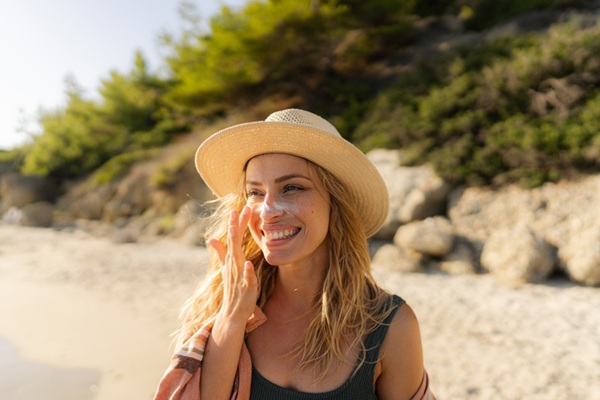Working Under the Sun: Gear Up Against Skin Cancer

Skin cancer is one of the most preventable types of cancer, yet it remains the most common form in the United States, with over five million cases diagnosed each year. The two most common types—basal cell carcinoma and squamous cell carcinoma—are classified as nonmelanoma skin cancers and are generally highly treatable when detected early, as they are less likely to spread. However, melanoma, the most serious form of skin cancer, has been steadily increasing for over 40 years. May is Melanoma and Skin Cancer Awareness Month, and although the warmer months are an appropriate time to address skin cancer, it’s important to be aware of the risks and implement safety practices year-round.
Risk factors for nonmelanoma skin cancer include:
- Being exposed to natural or artificial light for extended periods of time
- Fair skin
- Skin that freckles, burns easily, or tans poorly
- Blue, green, or light-colored eyes
- Red or blonde hair
- Having actinic keratosis—a precancerous condition caused by long-term sun exposure.
Additional risk factors for melanoma skin cancer include:
- Having a history of severe sunburns
- Having many moles or a family history of unusual moles
- Having a family or personal history of melanoma.
It's important to note that while individuals with certain characteristics, like fair skin, are at higher risk for skin cancer, people of all skin types and traits can develop it.
A study by the American Academy of Dermatology (AAD) revealed that outdoor workers are at a higher risk of developing skin cancer compared to the average American. Those working in fields such as construction, landscaping, emergency medical services, and postal delivery are frequently exposed to the sun. According to the study, 80% of outdoor workers reported getting a tan or noticing darker skin, compared to 67% of non-outdoor workers. Additionally, one in ten outdoor workers experienced sunburns severe enough to cause blisters.
Common barriers to sun protection include a lack of knowledge and widespread social norms. For example, 31% of outdoor workers believe the myth that a base tan prevents sunburns, and 20% of Americans believe tanning is safe if you don’t burn. Furthermore, many people enjoy having a bronzed glow, often feeling more confident with one.
There are several ways employers can help protect workers from sun exposure and support them in making healthy choices to reduce their risk of developing skin cancer.
Here are a few ideas:
- Raise awareness by integrating sun safety education into workplace wellness initiatives. Consider incorporating the following topics:
- Understanding skin cancer risks, as mentioned earlier.
- The importance of wearing water-resistant sunscreen with an SPF 30 or higher.
- Proper application techniques, including using at least one ounce of sunscreen 20 minutes before sun exposure, and being mindful of commonly missed areas such as ears, scalp, lips, neck, tops of feet, and backs of hands.
- Reapplication best practices of reapplying sunscreen every two hours—more frequently if swimming or sweating heavily.
- Clothing recommendations, encouraging protective clothing like wide brimmed hats; sunglasses; and dark, long sleeve shirts.
- Checking expiration dates, as sunscreen loses effectiveness over time
- Knowing the signs and symptoms of sun overexposure such as pain, redness or blisters.
Take it a step further by providing workers with sun-protective supplies and clothing, if resources allow.
- Adjust the workday to accommodate for sun safety if possible. According to the AAD, the sun’s rays are their strongest in the summer and between the hours of 10 a.m. and 2 p.m., though some sources note rays can remain high until 4 p.m. Harmful UV exposure can still occur on cloudy days and in cooler weather. Allowing workers to shift their schedules—opting for earlier mornings or later afternoons and evenings—can help them avoid the most intense sun hours and reduce their risk for developing skin cancer.
- Allow for shade or indoor break areas to offer relief from the sun and UV exposure, especially when outdoor work is required during peak sunlight hours.
- Partner with health care systems to support workers with having the option to receive skin checks. Although there is not enough evidence for or against the recommendation of routine screenings for skin cancer prevention, regular self-checks for moles or changes to the skin are strongly encouraged. Collaborating with a health care system can make it easier for workers to connect with providers if they notice any changes or have concerns about their skin.
While outdoor workers experience greater exposure to the sun and are at higher risk for skin cancer, simple adjustments to skin cancer awareness and sun safety messaging can make prevention strategies effective across all workplace wellness settings.
Resources:
Melanoma and Skin Cancer Awareness Month (aacr.org)
About the Contributor
Categories
- Belonging (3)
- Benchmarks (3)
- Benefits (4)
- Cancer (3)
- Culture (17)
- Emotional Wellness (14)
- Healthy Workplaces (13)
- Intellectual Wellness (14)
- Legal and Compliance (6)
- Mental Health (8)
- Occupational Wellness (11)
- Physical Wellness (16)
- Social Wellness (9)
- Spiritual Wellness (4)
- Wellness Alliance Events (3)
- Wellness Initiatives (12)
- Workplace Wellness (6)


